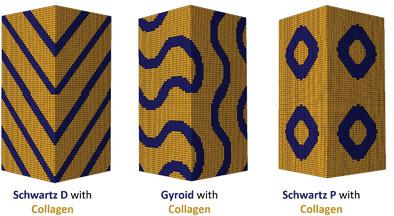当前位置:
X-MOL 学术
›
Macromol. Mater. Eng.
›
论文详情
Our official English website, www.x-mol.net, welcomes your feedback! (Note: you will need to create a separate account there.)
Micromechanical Behavior of TPMS Scaffolds for Bone Tissue Engineering
Macromolecular Materials and Engineering ( IF 3.9 ) Pub Date : 2020-10-12 , DOI: 10.1002/mame.202000487 André P. G. Castro 1 , Jorge Santos 1 , Tiago Pires 1 , Paulo R. Fernandes 1
Macromolecular Materials and Engineering ( IF 3.9 ) Pub Date : 2020-10-12 , DOI: 10.1002/mame.202000487 André P. G. Castro 1 , Jorge Santos 1 , Tiago Pires 1 , Paulo R. Fernandes 1
Affiliation

|
The triply periodic minimal surfaces (TPMS) methodology is explored to design porosity and curvature‐controlled tissue engineering (TE) scaffolds. This work combines mechanical testing and finite element (FE) simulation to characterize TPMS scaffolds micromechanical behavior, i.e., to estimate the response at the cell level to the macromechanical properties of different geometries (Schwartz D, Gyroid, and Schwartz P, with 60%, 70%, and 80% porosity, identified from SD60 to SP80) and testing conditions (6%, 8%, and 10% ramp compression, during 10, 20, and 30 s). Mechanical tests with ten 3D printed samples per model obtain Young Modulus levels from 0.048 GPa (SD80) to 0.267 GPa (SD60) and yield stresses from 0.495 MPa (SP80) to 5.226 MPa (SD60), being these associated with trabecular bone. FE simulations identify strain rate as the major influencer for cell response, as the probabilities for bone formation increase from 23.18% (SD) to 29.81% (SP) when increasing the compression period from 10 to 30 s. Additionally, compression beyond 6% causes excessive rates of cell death. SD and SG models have more consistent cell adhesion paths than SP ones, but superior stiffness of SD scaffolds induces higher cell death probabilities. Thus, SG scaffolds would be a better choice for most TE applications.
中文翻译:

TPMS支架在骨组织工程中的微力学行为
探索了三次周期性最小表面(TPMS)方法来设计孔隙率和曲率控制的组织工程(TE)支架。这项工作将机械测试和有限元(FE)仿真相结合,以表征TPMS支架的微观力学行为,即评估细胞水平对不同几何形状(Schwartz D,Gyroid和Schwartz P的响应,其中60%,从SD60到SP80确定了70%和80%的孔隙度,并在10、20和30 s的测试条件下(6%,8%和10%的斜坡压缩)进行了测试。每个模型用十个3D打印样品进行的机械测试获得的杨氏模量为0.048 GPa(SD80)至0.267 GPa(SD60),屈服应力为0.495 MPa(SP80)至5.226 MPa(SD60),与小梁骨有关。有限元模拟将应变率确定为影响细胞反应的主要因素,因为当压缩时间从10 s增加到30 s时,骨形成的概率从23.18%(SD)增加到29.81%(SP)。此外,压缩超过6%会导致细胞死亡率过高。SD和SG模型比SP模型具有更一致的细胞粘附路径,但SD支架的优异刚度诱导更高的细胞死亡概率。因此,SG支架对于大多数TE应用而言将是一个更好的选择。但是SD支架具有出色的刚度,可以诱导更高的细胞死亡概率。因此,SG支架将是大多数TE应用的更好选择。但是SD支架具有出色的刚度,可以诱导更高的细胞死亡概率。因此,SG支架将是大多数TE应用的更好选择。
更新日期:2020-12-15
中文翻译:

TPMS支架在骨组织工程中的微力学行为
探索了三次周期性最小表面(TPMS)方法来设计孔隙率和曲率控制的组织工程(TE)支架。这项工作将机械测试和有限元(FE)仿真相结合,以表征TPMS支架的微观力学行为,即评估细胞水平对不同几何形状(Schwartz D,Gyroid和Schwartz P的响应,其中60%,从SD60到SP80确定了70%和80%的孔隙度,并在10、20和30 s的测试条件下(6%,8%和10%的斜坡压缩)进行了测试。每个模型用十个3D打印样品进行的机械测试获得的杨氏模量为0.048 GPa(SD80)至0.267 GPa(SD60),屈服应力为0.495 MPa(SP80)至5.226 MPa(SD60),与小梁骨有关。有限元模拟将应变率确定为影响细胞反应的主要因素,因为当压缩时间从10 s增加到30 s时,骨形成的概率从23.18%(SD)增加到29.81%(SP)。此外,压缩超过6%会导致细胞死亡率过高。SD和SG模型比SP模型具有更一致的细胞粘附路径,但SD支架的优异刚度诱导更高的细胞死亡概率。因此,SG支架对于大多数TE应用而言将是一个更好的选择。但是SD支架具有出色的刚度,可以诱导更高的细胞死亡概率。因此,SG支架将是大多数TE应用的更好选择。但是SD支架具有出色的刚度,可以诱导更高的细胞死亡概率。因此,SG支架将是大多数TE应用的更好选择。


























 京公网安备 11010802027423号
京公网安备 11010802027423号